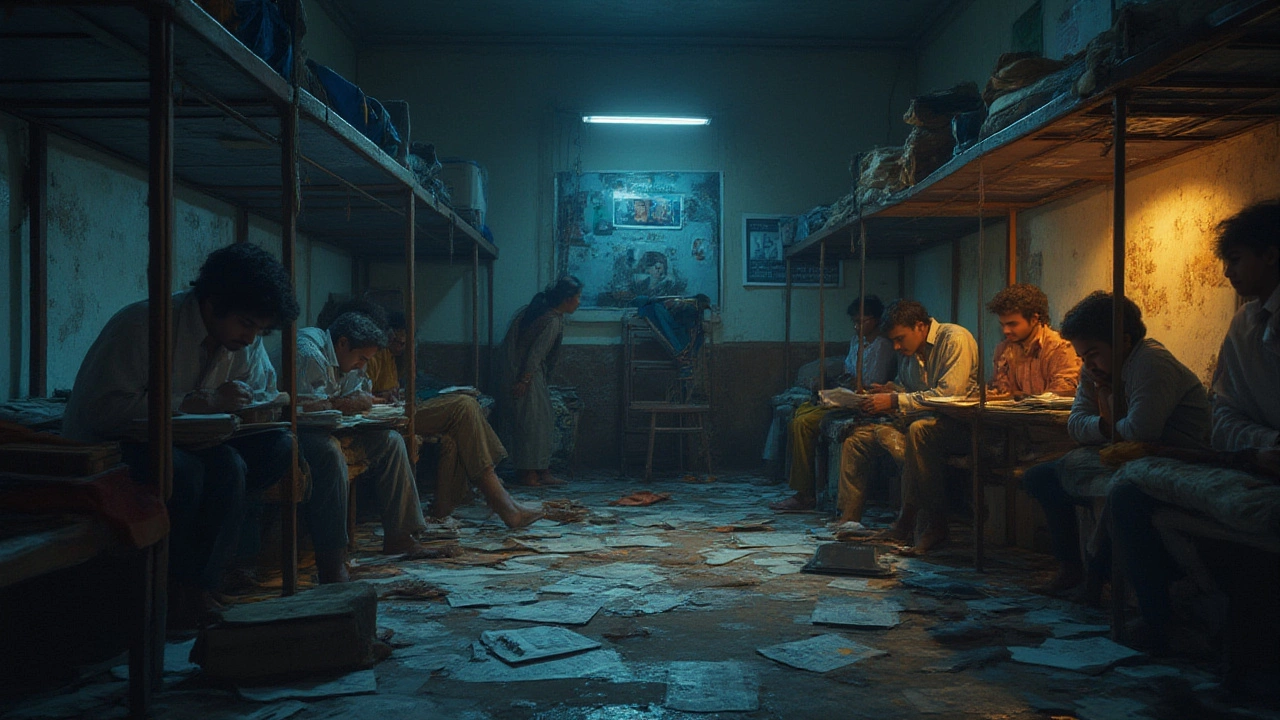Toughest Degrees in India: What Takes the Crown?
 Jul, 27 2025
Jul, 27 2025
Picture yourself stuck between a mountain of textbooks, endless entrance tests, and the dread of a single failed paper wiping out a year’s hard work. That’s the reality for thousands of Indian students who choose to go for the country’s toughest degrees. If you’re imagining IIT or CA, you’re on the right track, but there are a few surprises in store. Indian education is notoriously competitive, and some courses break spirits before they build careers. Ever wondered what it is about these degrees that sends grown men and women into panic mode?
The Meaning of "Toughest" in an Indian Degree
“Toughest” isn’t just about scary textbooks. In India, it’s a cocktail of cutthroat competition, brutal entrance exams, limited seats, and course structures that test your patience as much as your intelligence. Think of it this way—every year, more than a million teens chase a few thousand seats at elite colleges. The process starts with all-night study sessions in school, and for some, the stress only gets higher in college.
Why is this toughness part of the system? One reason is demand. Prestigious streams, like engineering or medicine, attract both students and parents, creating mad rushes at every step. And once you’re in, you face never-ending exams, project deadlines, and professors who aren’t exactly known for their hand-holding. It isn’t just about being smart; surviving these degrees is about mental stamina, resilience, and plain old grit.
These challenges aren’t the same for every degree. Engineering and medicine dominate the conversation, but there are niche streams (think Chartered Accountancy or law) with their own horror stories. While some degrees push you into memorizing years of facts, others ambush you with surprise practicals or mind-boggling legal judgments.
Competition is a different beast altogether. In the 2024 NEET exam, over 2.3 million students competed for barely 100,000 MBBS seats. The JEE Advanced, gatekeeper to the IITs, had around 180,000 qualifying candidates for just about 16,000 seats in 2023. If those numbers don’t give you goosebumps, I don’t know what will.
So, what makes a degree “toughest”? It’s a tricky mix—exam difficulty, seat scarcity, academic intensity, and the psychological toll of the ride.
Degrees That Keep Students Up at Night
Let’s get specific. The usual suspects top the list every year: IIT BTech, MBBS, Chartered Accountancy (CA), law (specifically the National Law Universities), and some niche design and architecture programs. Each comes with its own brand of pain, and here’s why.
MBBS has a fearsome reputation. It’s not just the cut-off marks—it’s surviving five and a half years of grueling classes, endless exams, and long hospital postings. The syllabus is gigantic—over 500 textbooks to reference, and the need to retain years of information about every muscle and cell in the body. Most students report working up to 16 hours a day, and yet, stress and burnout are common. Quoting a 2023 AIIMS student survey, 73% of first-year medicos found the reading load ‘overwhelming’.
Next, IIT BTech. The JEE Advanced is widely feared for good reason—it’s rated among the world’s hardest entrance exams. Less than 2% of aspirants clear it. Surviving in the IIT ecosystem is a marathon of back-to-back assignments, coding marathons, and occasional existential crises. The dropout rate isn’t as high as in some other countries, but academic pressure is relentless. If you think the nightmare ends with entrance tests, wait until you meet semester exams and never-ending lab work.
Chartered Accountancy (CA) is a different kind of monster. The pass rate for the CA Final hovers around 10–12%. Many give up after multiple attempts. The reason? You don’t just need to ‘pass’—most firms and employers want higher scores. And the slog isn’t just academic—the mandated training (articled clerkship) puts you through long months of office work with little pay. The odd part? There’s no mandatory full-time college for most of the course; discipline needs to come from within. No wonder so many CA students talk about burnout and extreme anxiety.
Law at India’s top National Law Universities (NLUs) comes with anxiety of a different flavor. The Common Law Admission Test (CLAT) is brutally competitive (1 in 50 get in). Once inside, the routine flips between endless legal readings, moots, internships, and projects. Success isn’t just about IQ; it demands memorization, persuasion, and insane time management.
Then there’s the less-expected: architecture (B.Arch), design (NID, NIFT), and even medical or engineering streams in top private or international tie-up colleges. Each has a different flavor—portfolio demands, creative exhaustion, or surprise jury presentations.
What’s common to all? Relentless pressure and the constant risk of falling behind with even a week off. These degrees demand not just intelligence but a blend of resilience and self-management that most teenagers never needed before. Some students develop insomnia or chronic stress; others become time-management wizards before hitting 19.

The Stats and Real Stories: The Numbers Don’t Lie
The numbers make the picture clearer. Here’s a comparison you don’t want to miss:
| Degree | Entrance Exam | Applicants (2024) | Seats | Selection Ratio |
|---|---|---|---|---|
| IIT BTech | JEE Advanced | 180,000 (qualified) | 16,000 | ~9% |
| MBBS | NEET | 2,300,000 | 100,000 | ~4% |
| CA | CA Foundation/Inter/Final (no fixed seats) | 200,000+ | N/A | Pass rate: 10–12% |
| NLUs (Law) | CLAT | 60,000 | 3,000 (UG) | ~5% |
| Design (NID/NIFT) | NID, NIFT Entrance | 30,000+ | 2,000+ | ~6% |
But these are just numbers. Daily stories drive home why these degrees have their fearsome reputation. I know students who cracked JEE after four years of prep, only to discover mid-way through their IIT course that academic pressure never really lets up. A med student I spoke to last year described a first-year “practical” where she fainted, only to be told by seniors that this happened to ‘at least two people’ every month. CA aspirants often joke that “CA stands for ‘Come Again’,” with students retaking finals two or three times before clearing. Law students, especially at NLUs, talk of all-nighters before moot court rounds or internships, squeezed between intern duties and classes.
There’s also the pressure cooker atmosphere in hostels. It used to be urban legend, but a recent study from a Delhi NGO found that mental health visits among undergraduates at top colleges (especially IITs and AIIMS) went up by 25% between 2018 and 2023. This isn’t just about exams—it’s about the pressure to keep performing, to always have an offer letter lined up, or to never be seen as the ‘weak link’ in a group of achievers.
Unique Features That Make These Degrees So Arduous
Let’s break down what makes each of these degrees uniquely hard—not just exam stress, but the quirks that make them legendary for sleepless nights.
- Mandatory Internships and Rural Postings: MBBS students face rural postings and mandatory internships after 4.5 years of theory. This isn’t just about managing hospital work but coping with limited resources, language barriers, and high patient inflow. Many see and experience things most people never do until their 30s.
- Surprise Projects, Endless Tests: IITs and top engineering colleges are famous for surprise assignments, unannounced quizzes, and a grading system that pits students against each other (the “relative grading” means being above average is never enough).
- No Breaks—CA as a Marathon: The CA degree doesn’t run on a predictable college calendar. Exams can clash with work deadlines, and there’s no college fest or annual break—just endless cycles of exam, result, repeat.
- Pressure Cooker Hostels: Competitive hostels can breed both camaraderie and ruthless pressure. Among IITians, the saying goes, “Either you help your friend, or become their competitor.”
- Financial Pressure: In courses like CA and even some private MBBS colleges, financial pressure is enormous. MBBS in a private seat can go above INR 1 crore (over $120,000), with no guarantee of stellar ROI. CA aspirants, meanwhile, often work low-paying clerk jobs during their articled years. This can leave students counting every rupee while battling burnout.
- Society and Parental Expectations: In India, your degree status can make or break family honor, especially if you’re an only child. Failing an exam doesn’t just make you feel bad—it’s a social event. This adds a different sort of weight to every test paper or semester result.
- Ever-changing Syllabus: Engineering and law students often joke about buying the “right” textbooks, only to have the syllabus change every year. It isn’t unusual for a few marks to make the difference between a scholarship and repeating a semester.
- Unpredictable Practical Exams: Medical students are haunted by the oral exam—a senior doctor can quiz you on any topic, and many students stumble even after months of prep.
Then there’s the stuff they don’t tell you in the brochures. The social isolation of intense study regimes. The healthy eating and sleeping habits that vanish by the first semester. And don’t even get me started on the group project dramas (spoiler: at least one person will try to cruise on your efforts every year).

Tips for Surviving — and Thriving — in These Degrees
If you’re planning to go for one of these punishing degrees, it isn’t all doom and gloom. Millions do survive—and some even find purpose amid the chaos. Here are tricks and tips students swear by (these aren’t recycled clichés):
- Break your prep into sprints: Instead of aiming for six months of full-throttle revision, break things down to week-by-week goals.
- Find your tribe: Having a small but solid friend group isn’t just good for study sessions—it keeps you sane. Tech or med “study groups” work best with 3–5 people who keep each other honest.
- Burnout is real, so schedule time off like it’s an assignment. Many survivors plan ‘zero study’ Sundays or unplug after 10pm, no matter what.
- Ask for help when stuck: Most institutions now have counselors (not always world-class, but better than nothing). Don’t power through crippling stress—ask seniors or mentors for real stories, not sugar-coated advice.
- Take past papers seriously: This isn’t just old school advice. Most entrance and finals in India love repeating or twisting previous questions. Get your hands on at least 5–10 years’ worth of old papers before every big exam.
- Figure out what professors want: Sad, but true. In many colleges, faculty have pet topics and favorite formats. If you want to crack practicals or vivas, find out what your examiners focus on—ask seniors who survived their test.
- Don’t compare: Your roommate may ace one subject but struggle in others. Run your own race—you’re not living their life or career.
- Use tech wisely: There’s a YouTube channel or Telegram group for literally every niche topic now. Use it. But remember—watching 20 videos isn’t the same as solving 20 real problems.
The *toughest degree in India* will always be more than just textbooks or exam stats. It’s about the system, the expectations, and the sheer volume of kids fighting for a slice of opportunity. But it’s also about making friends for life, building discipline, and learning more about yourself in five years than most people do in a decade. If you’re planning to take the plunge, arm yourself with the right tools, expect bad days, and remember—sometimes, just surviving counts as winning.